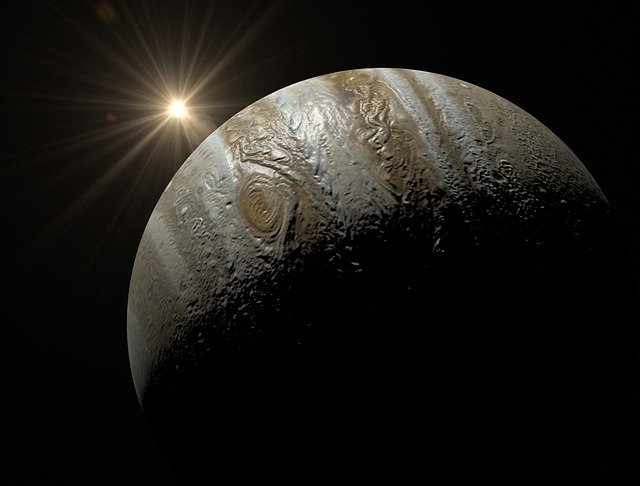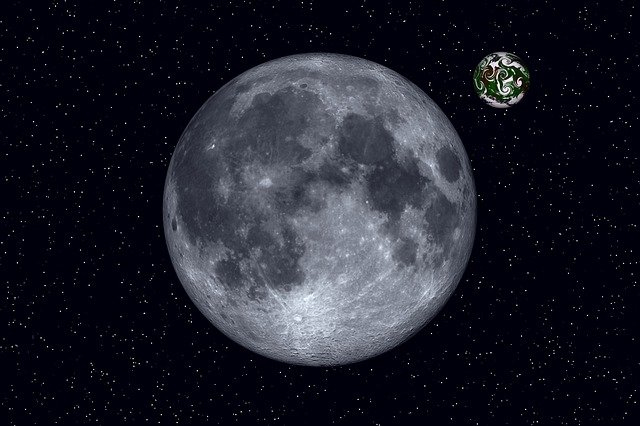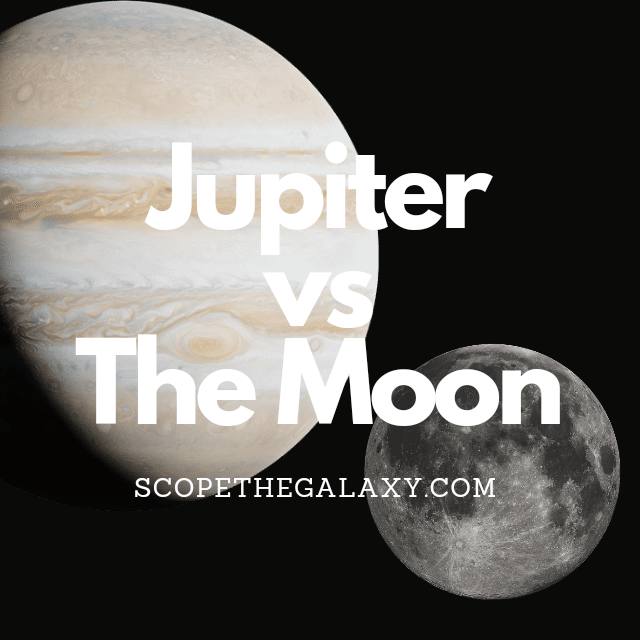*This post may contain affiliate links. This means we may make a commission if you purchase an item using one of our links*
The main differences between Jupiter and the Moon is that Jupiter is the largest planet in our solar system, is a gas giant composed mostly of hydrogen and helium, has 79 moon and the strongest magnetic field in our solar system whilst the Moon is the 5th biggest moon, orbits the Moon, has an extremely thin exosphere and has a rocky surface.
There are numerous other differences between the two so, continue reading for a more thorough breakdown of the similarities and differences between the two.
What Is The Planet Jupiter?
Table of Contents

Jupiter is the 5th farthest planet from the Sun and the largest planet within our local solar system. The planets most recognizable trait is the giant red spot visible on its atmosphere along with the brown horizontal bands flowing across its atmosphere.
As a result of its composition and size, Jupiter falls under the classification of a gas giant.
This is because its composition mostly consists of the elements hydrogen and helium. The split is roughly 71% hydrogen, 27% helium, with the remainder of the elements split throughout the left over 2%.
As the biggest planet in our solar system, Jupiter is 139,820 km or 1,300 Earths in diameter, it has a mass of around 0.001 solar masses, the temperature when inside the clouds are roughly -145 degrees Celsius whilst the core is far hotter, equating in the region of 24,000 degrees Celsius.
Due to its extreme circumstances, gaseous composition and distance from the Sun, the planet is not theoretically capable to support life, from its subzero temperature to the extremely fast 640 km/h winds, and its gravity which may be unsustainable for our bones, roughly 2.4 times greater than Earth’s.
Although the conditions on Jupiter aren’t suitable for us, some of its 79 moons like Europa for example could support life.
This brown giant has a relatively fast rotation around its axis where 1 rotation typically takes 10 hours to make whilst its orbit around the Sun is far longer taking in the region of 12 years for 1 full cycle.
Another feature of Jupiter that is renowned by astronomers is the strength of its magnetic field. In comparison to the other planets in our solar system it is even stronger than our Sun, where it’s over magnetosphere is roughly 20,000 times the strength of Earth.
What this means is that Jupiter’s magnetosphere is able to avert solar winds that are 3 million kilometers away from it
What Is The Moon?

The Moon is the gray celestial being that orbits our Earth. It is also tidally locked to Earth meaning that we only see one side of it at any time in our sky.
It takes the moon roughly 27 days to complete an orbit around Earth, which it does in an elliptical pattern. The Moon’s axial tilt is very straight at 1.5 degrees. As a result of the tidally locked status along with the effects that Earth has on Its general rotational patterns, it takes the Moon roughly 29.5 days to complete a day.
In regards to its temperature, it fluctuates where it can be really hot at 127 degrees Celsius when the Sun is shining on it and to -173 degrees in areas where the Sun does not strike. It’s core on the other hand is far hotter ranging between 1,327 to 1,427 degrees Celsius.
This is as a result of the lunar entity’s extremely thin to practically non-existent atmosphere, which not only results in these massive temperature shifts but, is also the reason why it has over 100,000 craters on its surface.
Speaking of the Moon’s surface, the entity is mostly made of rocks, iron, magnesium just like most of the other moons and terrestrial based planets in our solar system.
It is among the bigger moons in our solar system with a diameter of 3,474.8km and a mass of 7.35 × 10^22 kg, which actually places it fifth amongst all moons in our solar system and would also make it bigger than the dwarf planet Pluto.
Despite all the advancements in technology, the last time a manned mission was made to the Moon was on the Apollo 17 way back in December 1972 and no further missions have been done since, possibly as result of the political agendas behind the numerous countries vying for opportunities that we don’t know of.
Similarities Between Jupiter And The Moon
There aren’t many similarities between Jupiter and the Moon but, a few features are shared, which in this case includes the below:
- Both are a spherical shape.
- Both have a hotter core.
- Both also orbit another entity.
- Both have an axial tilt of less than 5 degrees.
Differences Between Jupiter And The Moon
In regards to the differences between the two, they include the following:
- The Moon is a natural satellite that orbits Earth in 27 days whilst Jupiter is a a gas giant that orbits the Sun, where a full cycle takes 12 years.
- The Moon completes a day in 29.5 days whereas Jupiter’s day takes 10 hours.
- Jupiter has an axial tilt of 3.13 degrees whilst the Moon’s axial tilt is 1.5 degrees.
- The Moon has a more erratic temperature pattern where it can range between 127 degrees and -173 degrees Celsius whilst Jupiter’s average temperature is -145 degrees Celsius.
- Jupiter has 79 other moons orbiting it whilst the the Moon has no other object orbiting it.
- Jupiter has the strongest magnetic field in our solar at 4.3 gauss, which is also stronger than the Sun and much stronger than the Moon.
- Jupiter’s core is hotter than the Moon’s where it is 24,000 degrees Celsius whilst the Moon’s core is between 1,327 – 1,427 degrees Celsius.
- Jupiter is far bigger than the Moon with a diameter of 139,820km as opposed to the Moon’s 3,474.8km.
- Jupiter’s mass is 1.898 × 10^27 kg whilst the Moon’s mass is 7.35 × 10^22 kg.
- The Moon orbits Earth in an elliptical pattern whilst Jupiter orbits the Sun in a circular pattern.
- The Moon’s density is 3.34 g/cm³ as opposed to Jupiter’s is less at 1.33 g/cm³.
- Jupiter’s gravitational strength is 24.79 m/s² as opposed to the Moon’s that is 1.62 m/s².
Summary
The Moon is simply a natural satellite that orbits Earth whilst Jupiter is the biggest planet in our solar system, composed of gasses similar to that of our Sun, is generally the colder of the two and has 79 other natural satellites (some bigger than the Moon) orbiting it.
Jupiter is clearly very different from the Moon and they simply do not fit into the same category of celestial objects despite the fact that they exist in the same solar system.


